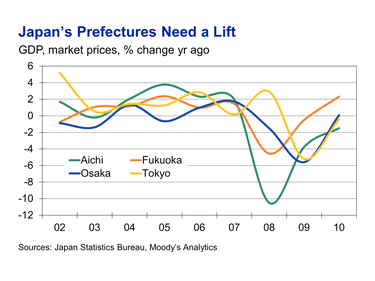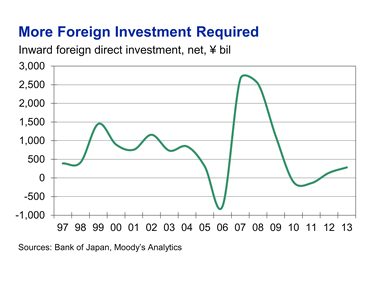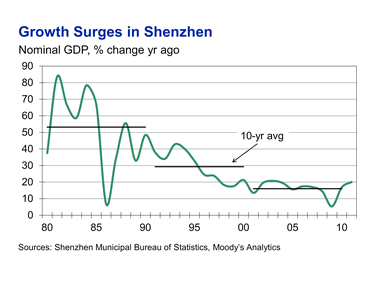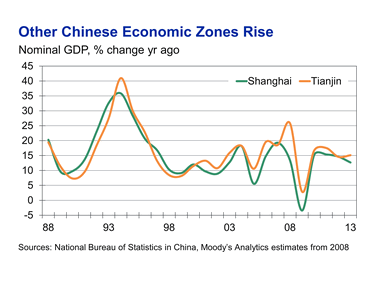28 January 2014
Matthew Circosta
Moody’s Analytics
- The success of Japan’s new economic zones hinges on the implementation of much-needed reforms in healthcare, agriculture, and the labour market.
- Building restrictions have been eased, but lowering corporate tax rates creates challenges.
- Japan can look to Shenzhen as a guide for a successful economic zone.
Prime Minister Shinzo Abe’s plan to establish “special economic zones” provides a test for his broader reform agenda, and ultimately, whether he can put the Japanese economy on a sustainable growth path. The rise of Shenzhen in China offers hope that it can be achieved, though Abe’s plans face many challenges.
The zones structure
Locations for the new Japanese zones have yet to be announced, but the most likely areas for development are in Tokyo, Osaka, Nagoya and Fukuoka, which combined account for more than one-third of national GDP and more than 25% of the population. This suggests the economic impact could be sizeable if Abe plays his cards right.
These include lower corporate taxes, fewer building restrictions, relaxed immigration laws, and deregulation, which Abe hopes attracts more foreign firms to Japan and prompts local corporates to spend more at home than overseas. The aim is to turn the zones into global hubs such as London, Hong Kong or New York.

Progress has been mixed. Building restrictions have been eased, which should support stronger residential construction and lift house prices. Increased building should also help lift housing demand and have positive spillover effects for education, healthcare and retail as well as employment.

But the plan to lower corporate tax rates creates a dilemma. If they aren’t lowered, it could deter business startups, but doing so would add pressure on government revenues and exacerbate the government’s already-poor fiscal position. Japan has the second highest corporate tax rate in the OECD; most are calling for the rate to be cut to 25% (from about 35%), while authorities in Tokyo and Osaka want it lowered to 20% so it is comparable with those of Hong Kong (16.5%) and Singapore (17%).
Reform is the key
The zones have a shot at fulfilling the third arm of Abe’s bold plan—wide-ranging structural reforms. Making the labour market more dynamic and reforming healthcare and agriculture are seen as crucial if Abe’s plan is to work. Testing reforms in smaller areas before instituting them nationwide is also seen as politically easier, but only if the government can limit pressure from lobbyists. Measures to liberalise online sales of over-the-counter drugs, for example, have been dialed back because of strong opposition from vested interest groups.
Even so, authorities must not take their eye off the ball if they are to succeed. Labour market initiatives such as giving employers more flexibility over hiring and firing and fewer restrictions on temporary workers would help improve productivity and make doing business in Japan more attractive for foreign firms. Raising female workforce participation would also help lift employment, household incomes, and potential GDP growth.
The government is already trying to eliminate protectionist policies and subsidies that have lowered efficiency and productivity in Japan’s agricultural sector. An agricultural zone on the island of Hokkaido is also being mooted; proposed policy changes would allow farmers to own land rather than rent it, which could potentially raise their wealth.
The rise of Shenzhen
Shenzhen is seen as the poster child of a free-market economy. Japan may not be able to emulate Shenzhen’s performance over the past three decades, but it can look to that city for hope. Former Chinese leader Deng Xiaoping in 1980 opened up Shenzhen to foreign investment in low-end manufacturing to boost exports and employment. The move helped spur the city’s economic growth, which averaged more than 50% from 1980 to 1990 and continues to grow more quickly than the rest of the country. It also helped lift millions out of poverty.

Deng then instituted these reforms in places including Shanghai, Guangzhou and Tianjin in 1986, which helped to lift wages and living standards, and economic gains spread across the country.

Current Premier Li Keqiang is building on the reform work of former leaders. He is establishing a new free-trade zone in Shanghai, where policymakers are liberalising interest rates, allowing greater trade in yuan, and enticing investment in the finance, shipping, and other service industries, with the aim of transitioning China from a low- to a high-income economy.
Can Abe succeed?
Whether targeted economic zones will lift Japan’s growth remains questionable. Japan has been down this route before, with mixed results. Junichiro Koizumi created many special economic zones when he was prime minister from 2001 to 2006, but pressure from vested interest groups hindered their progress. More recently, the Democratic Party of Japan has had better results, with Fukuoka, for instance, benefiting from incentives for the environmental technology industry. But authorities in Fukuoka are concerned that any new zones could draw investment away from existing zones.
Some argue that if the reforms fail, the effects could be large given the size of the proposed zones. Other critics say the government should go all in and embark on nationwide reform. Whatever the case, Shenzhen offers a guide as to what can happen when it all goes right.
Courtesy of Moody’s Analytics
